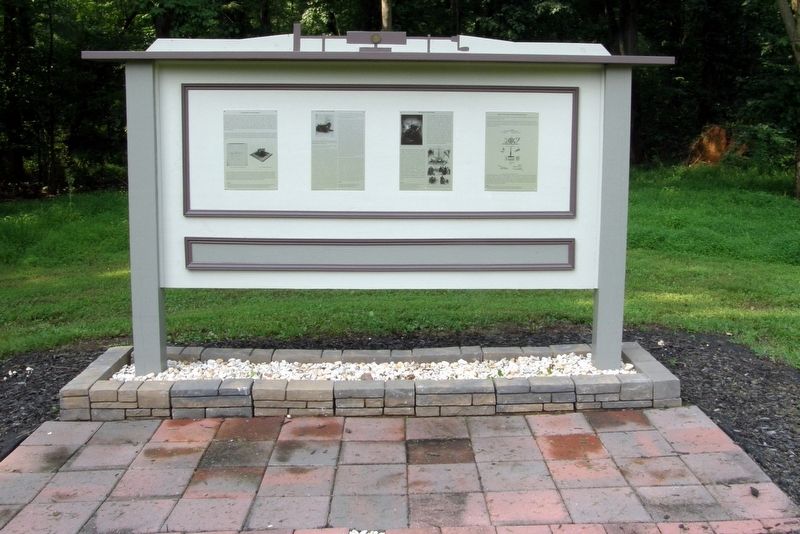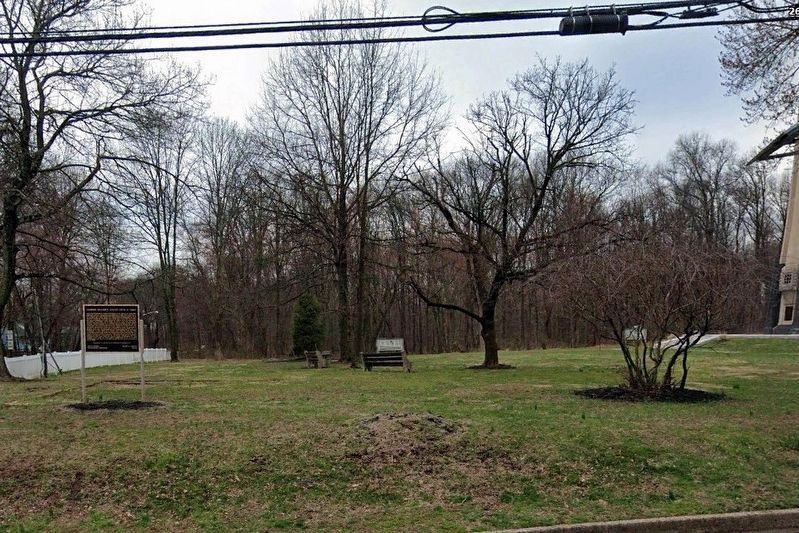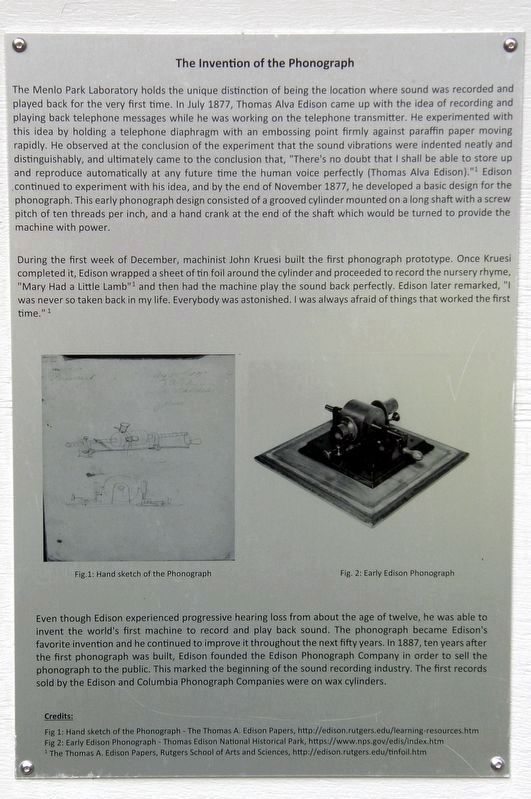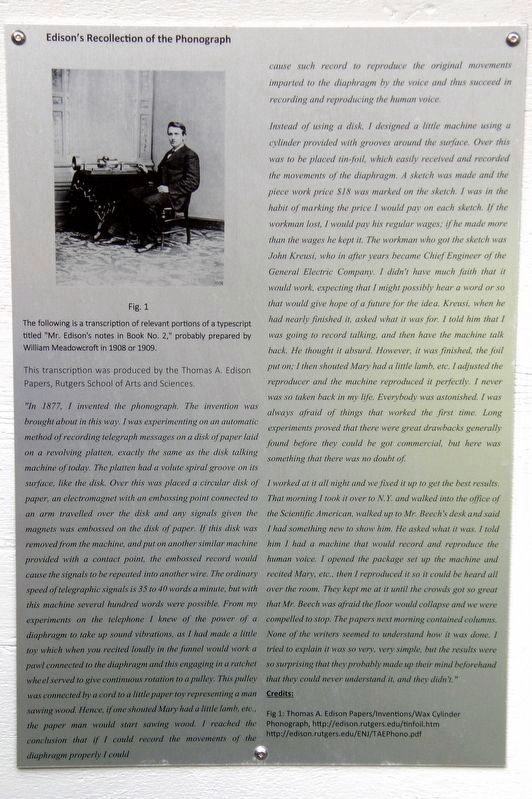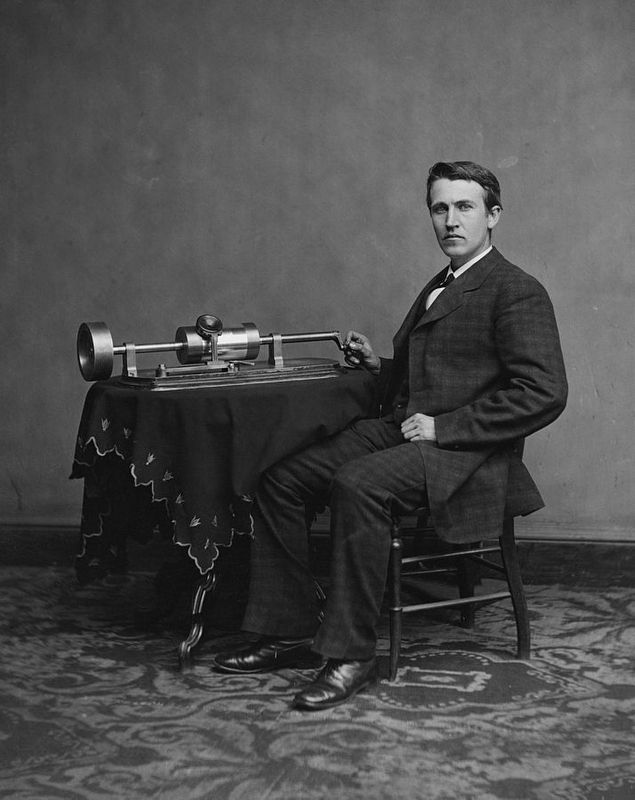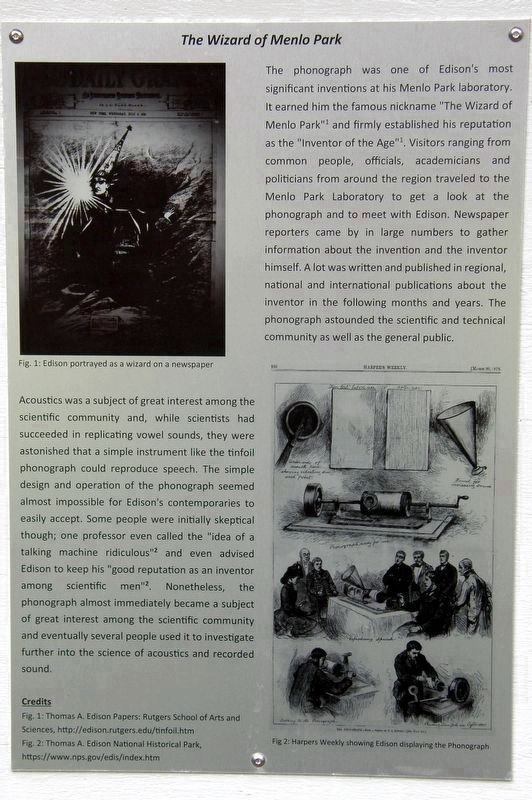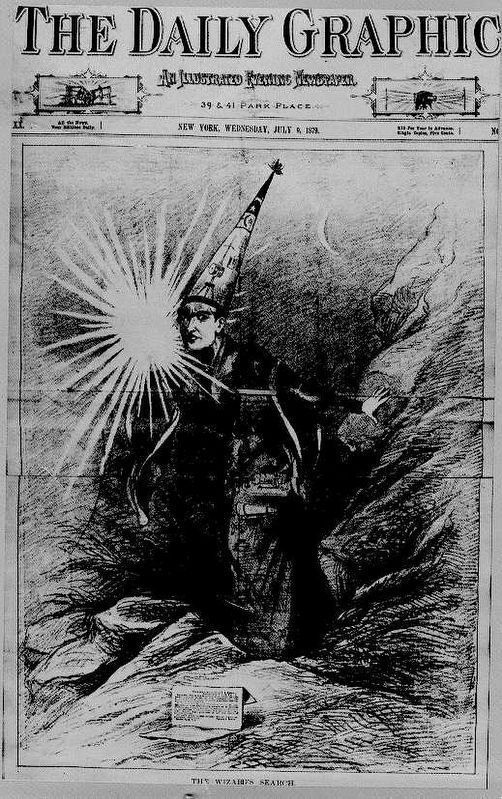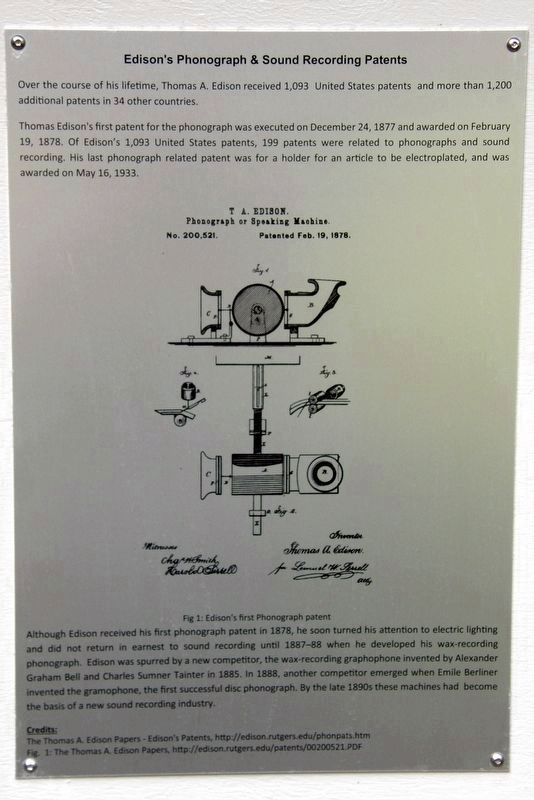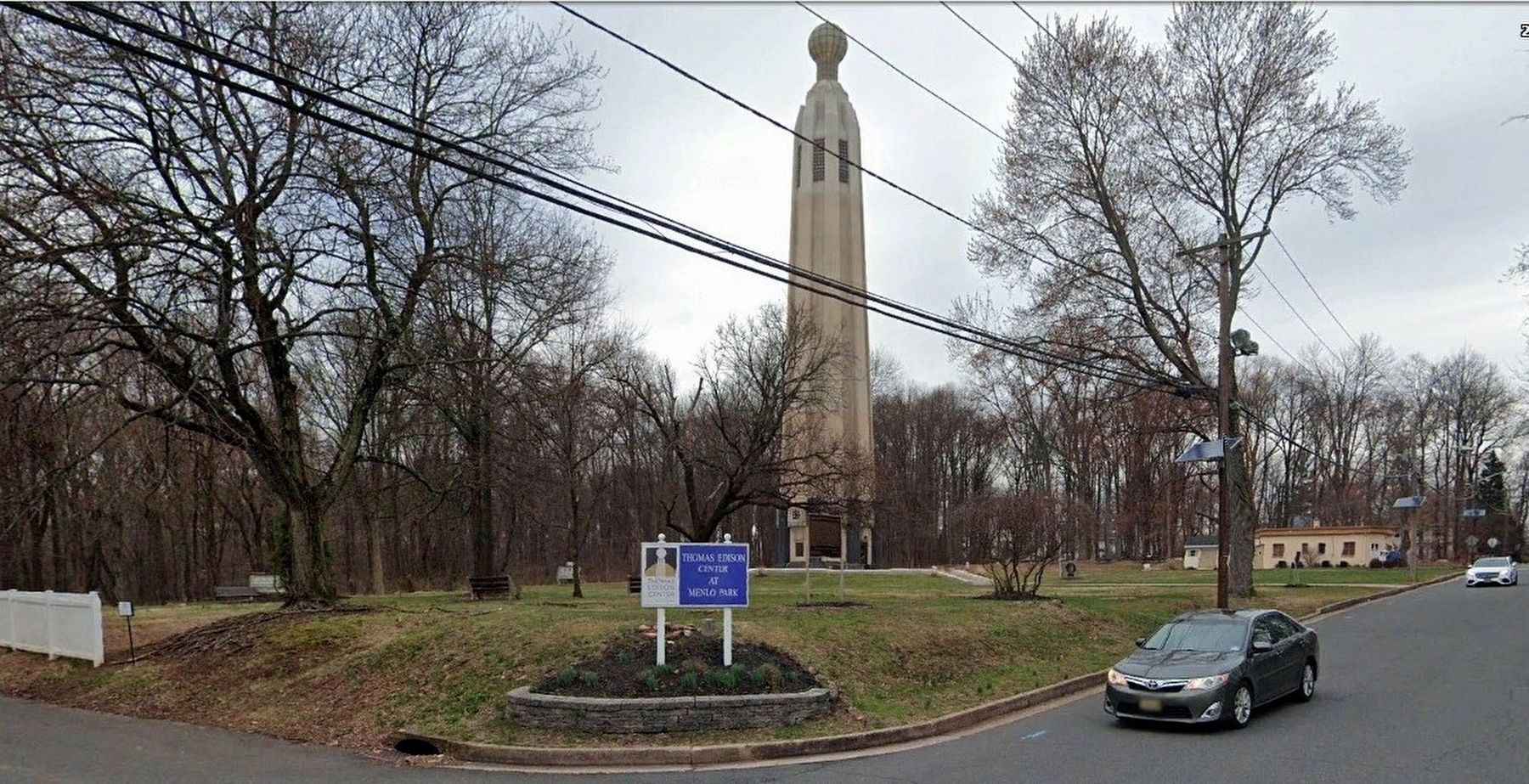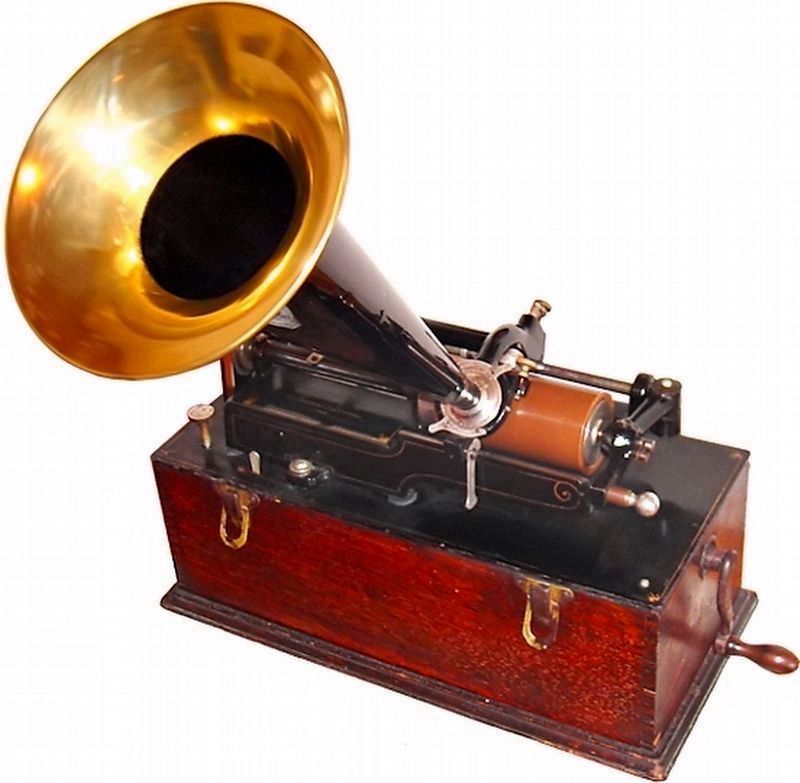Menlo Park in Middlesex County, New Jersey — The American Northeast (Mid-Atlantic)
The Invention of the Phonograph
Plaque 1:
The Menlo Park Laboratory holds the unique distinction of being the location where sound was recorded and played back for the very first time. In July 1877, Thomas Alva Edison came up with the idea of recording and playing back telephone messages while he was working on the telephone transmitter. He experimented with this idea by holding a telephone diaphragm with an embossing point firmly against paraffin paper moving rapidly. He observed at the conclusion of the experiment that the sound vibrations were indented neatly and distinguishably, and ultimately came to the conclusion that, “thereís no doubt that I will be able to store up and reproduce automatically at any future time the human voice perfectly (Thomas Alva Edison).” Edison continued to experiment with his idea, and by the end of November 1877, he developed a basic design for the phonograph. This early phonograph design consisted of a grooved cylinder mounted on a long shaft with a screw pitch of ten threads per inch, and a hand crank at the end of the shaft which would be turned to provide the machine with power.
During the first week of December, machinist John Kruesi built the first phonograph prototype. Once Kruesi completed it, Edison wrapped a sheet of tin foil around the cylinder and proceeded to record the nursery rhyme, “Mary Had a Little Lamb” and then had the machine play the sound back perfectly. Edison later remarked, “I was never so taken back in my like. Everybody was astonished. I was always afraid of things that worked the first time.”
Even though Edison experienced progressive hearing loss from around the age of twelve, he was able to invent the worldís first machine to record and play back sound. The phonograph became Edisonís favorite invention and he continued to improve it the next fifty years. In 1887, ten years after the first phonograph was built, Edison founded the Edison Phonograph Company in order to sell the phonograph to the public. This marked the beginning of the sound recording industry. The first records sold by the Edison and Columbia Phonograph Companies were on wax cylinders.
Plaque 2:
Edisonís Recollection of the Phonograph
A transcription of “Mr. Edisonís notes in Book No.2”, the relevant parts of which are condensed above
Plaque 3:
The Wizard of Menlo Park
The phonograph was one of Edisonís most significant inventions at his Menlo Park laboratory. It earned him the famous nickname “The Wizard of Menlo Park” and firmly established his reputation as the “Inventor of the Age”. Visitors ranging from common people, officials, academics and politicians from around the region
traveled to the Menlo Park laboratory to get a look at the phonograph and to meet with Edison. Newspaper reporters came by in large numbers to gather information about the invention and the inventor himself. A lot was written and published in regional, national and international publications about the inventor in the following months and years. The phonograph astounded the scientific and technical community as well as the general public.
Acoustics was a subject of great interest among the scientific community and, while scientists had succeeded in replicating vowel sounds, they were astonished that a simple instrument like tinfoil phonograph could reproduce speech. The simple design and operation of the phonograph seemed almost impossible for Edisonís contemporaries to accept. Some people were initially skeptical through; one professor even called the “idea of a talking machine ridiculous” and even advised Edison to keep his “good reputation as an inventor among scientific men”. Nonetheless, the phonograph almost immediately became a subject of great interest among the scientific community and eventually several people used it to investigate further into the science of acoustics and recorded sound.
Plaque 4:
Edisonís Phonograph & Sound Recording Patents
Over the course of his lifetime, Thomas A. Edison received 1,093 United States patents and more than 1,200 additional patents in 34 other countries.
Thomas Edisonís first patent for the phonograph was executed on December 24, 1877 and awarded February 19. 1878. Of Edisonís 1,093 United States patents, 199 patents were related to phonographs and sound recording. His last phonograph related patent was for a holder for an article to be electroplated, as was awarded on May 16, 1933.
Although Edison received his first phonographic patent in 1878, he soon turned his attention to electric lighting and did not return in earnest to sound recording until 1887-88 when he developed his wax-recording phonograph. Edison was spurred by a new competitor, the wax-recording graphophone invented by Alexander Graham Bell and Charles Sumner Tainter in 1885. In 1888, another competitor emerged when Emile Berliner invented the gramophone, the first successful disc phonograph. By the late 1890s these machines had become the basis of a new sound recording industry.
Topics. This historical marker is listed in these topic lists: Industry & Commerce • Parks & Recreational Areas • Science & Medicine. A significant historical date for this entry is February 19, 1878.
Location. 40° 33.771′ N, 74° 20.332′ W. Marker is in Menlo Park, New Jersey, in Middlesex County. Marker is on Tower Street south of Christie Street, on the right when
traveling south. Touch for map. Marker is at or near this postal address: 37 Christie Street, Edison NJ 08837, United States of America. Touch for directions.
Other nearby markers. At least 8 other markers are within 2 miles of this marker, measured as the crow flies. Thomas Alva Edisonís Menlo Park Invention Factory (within shouting distance of this marker); Thomas Alva Edison Memorial Tower (within shouting distance of this marker); Thomas Edisonís Office 1879 to 1884 (within shouting distance of this marker); Sarah B. Jordan Boarding House (about 300 feet away, measured in a direct line); Thomas Edison and the Electric Railway (about 300 feet away); Thomas Alva Edison Menlo Park Memorial (approx. 0.2 miles away); Menlo Park Terrace (approx. 0.9 miles away); First Presbyterian Church Of Iselin (approx. 1.1 miles away). Touch for a list and map of all markers in Menlo Park.
Also see . . . History of the Cylinder Phonograph. Library of Congress entry (Submitted on December 15, 2020, by Larry Gertner of New York, New York.)
Credits. This page was last revised on February 18, 2021. It was originally submitted on December 15, 2020, by Larry Gertner of New York, New York. This page has been viewed 650 times since then and 43 times this year. It was the Marker of the Week February 14, 2021. Photos: 1, 2, 3, 4, 5, 6, 7, 8, 9, 10. submitted on December 15, 2020, by Larry Gertner of New York, New York. 11. submitted on February 13, 2021, by J. J. Prats of Powell, Ohio.
